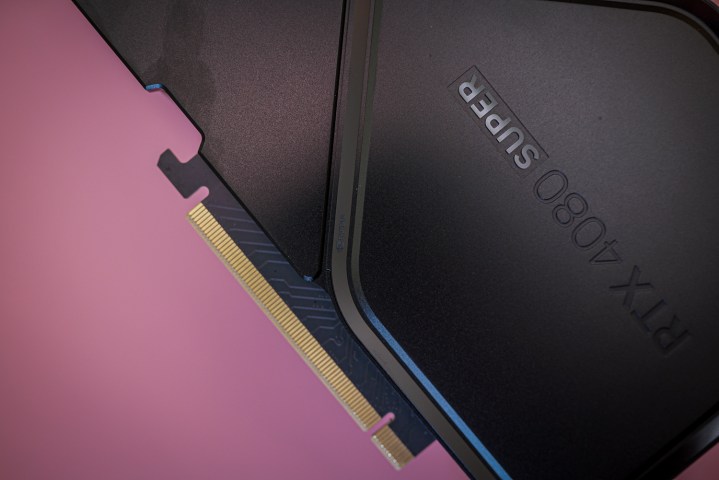The Nvidia RTX 5080 didn’t blow the doors off our test rig when we put it through its paces, but it did show itself to be a very fast, modern GPU with a range of exciting features. But how much faster is it than its last-generation counterpart? And is it worth upgrading to if you’re a generation behind?
If you’d rather just buy the best graphics card right now, we have a guide for that. But if you’re curious how the RTX 5080 and 4080 Super match up, here’s how.
Specs
| Nvidia RTX 5080 | Nvidia RTX 4080 Super | |
| CUDA Cores | 10,752 | 10,240 |
| RT Cores | 84, 4th generation | 80, 3rd generation |
| Tensor Cores | 336, 5th generation | 320, 4th generation |
| Boost clock | 2.6GHz | 2.55GHz |
| Memory size | 16GB GDDR7 | 16GB GDDR6X |
| Memory bus | 256-bit | 256-bit |
| Memory speed | 30Gbps | 23Gbps |
| Memory bandwidth | 960GBps | 736.3GBps |
| TBP | 360W | 320W |
Spec for spec, there isn’t much that separates these two cards. The RTX 5080 has just five percent more CUDA cores, a boost clock that’s almost identical, the same quantity of memory, and the same bus width. RT and Tensor cores are a new generation, so should perform better, but core counts are nearly identical.
The only real change with the RTX 5080 besides the Blackwell architecture, is the faster GDDR7 memory, which takes the overall memory bandwidth up a couple of hundred Gigabytes per second. But that added power does come at the cost of extra power demands, with a near-15% higher TDP.

If Blackwell was such a major redesign of Nvidia’s GPU architecture that we could expect big gains from that alone, we might be more excited. Multiple frame generation is a nice feature for the newer card which the 4080 Super can’t offer, but outside of that, there’s not even much to be excited about on paper.
But what about the real world?
Performance
Unfortunately, the RTX 5080 doesn’t pull any big surprises out of the hat when it’s running games. At 4K, where this card should really sing, it does beat out the RTX 4080 Super, but not by any huge margins. Overall, it’s around 20% faster, but there are some games where it’s much closer and even a few where the 4080 Super is able to keep pace with the newer card.
That’s without all the added potential of multiple frame generation, but that’s hardly a universal feature and not one everyone even likes enabling.

The story at 1440p is very similar, but with even less of a gap between these two cards. The performance uplift from the 5080 here is closer to 16%, further highlighting the limited benefit of upgrading from the older 40-series card to its 50-series alternative.

One area where the RTX 5080 holds a strong advantage, at least, is in ray tracing. There we saw a much greater generational uplift and it’s one of the few instances where the RTX 5080 offers credible competition to the last-generation king, the RTX 4090. The fact it can retain 60 FPS in Black Myth: Wukong, even with DLSS helping it along, is a solid achievement.

The multi-frame generation is a solid win for the RTX 5080, though. In compatible games where the frame rate might not be as smooth as you’d like (but still high enough to feed the algorithm enough frames to work with) it can double, or even triple your frame rate, which can make everything far smoother. It’s something the RTX 4080 Super can approximate with its older tensor cores and single frame gen option, but it’s not in the same ballpark as what the 5080 can manage.
With DLSS 4 as well, multi-frame generation can be a potent combination for hitting crazy frame numbers — like 200+ FPS at 4K in some games. But outside of those specific experiences, the 5080 doesn’t do much that the 4080 Super can’t do already.
Thermals and sizing
The RTX 4080 Super comes with the same overbuilt cooler as the RTX 4090 (in reference design at least), so it’s incredibly cool and quiet for such a high-end GPU. But it is massive, taking up four slots and barely fitting in even large ATX cases.

With the RTX 5080 Nvidia worked some magic to develop a truly miniscule cooler for such a demanding card. It’s just two slots wide, making it more viable for small form factor PCs. It does, however, draw a monstrous 360W of power, so it will make small case systems hot, even if the GPU itself stays relatively cool and quiet.
The RTX 4080 Super might be a better bet…
The RTX 5080 should be the high-end RTX 50-series card we’re recommending, but it’s really hard to. Its generational performance uplift isn’t that impressive, it’s limited to just 16GB of VRAM, which is already being saturated by some of the most demanding games, and its pricing is already going crazy. Suggested retail at $1,000 is all well and good, but stock is limited and third parties are already pushing that price to around $1,500 on some models. Not to mention what scalpers will do.
Not that the 4080 Super is easy to get hold of at a good price, either. If you can, it’s still a fantastically capable card and you might be able to snatch a bargain from a retailer that isn’t quite up with the times. But a quick glance around today shows them out of stock just about everywhere.
Want some alternatives? Here are the cards we recommend you buy instead of the 5080. Alternatively, consider waiting to see what AMD’s RX 9070 has to offer. It might be competitive. We just don’t know enough to say for sure, yet.





